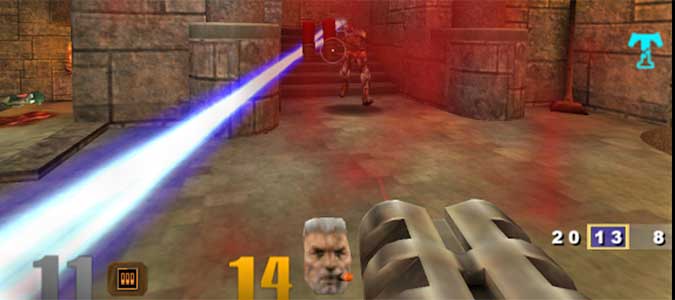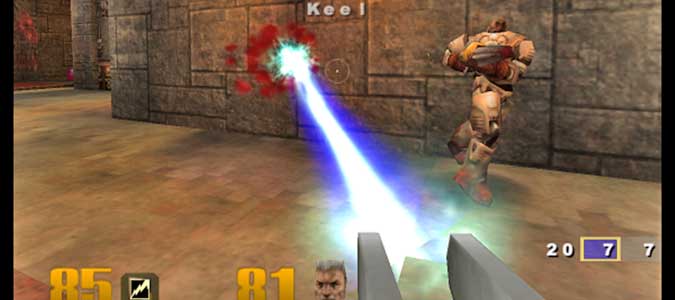This page may contain one or more affiliate links, which means that if you purchase a product through that link, I may receive compensation. The links will be identified with the text "affiliate link". Click to learn more.
Once upon a time, I had the demo of Quake III Arena, the iconic multiplayer first-person shooter developed by id Software. It came with a mere handful of content – just 4 maps and 3 characters – but that limitation did nothing to diminish my obsessive dedication to the game. I played it religiously, every single morning, before heading off to work or school. Looking back, it wasn’t just a hobby – it was a full-blown addiction. The catch? I was doing something rather mischievous: playing through a dial-up modem, which was definitely not the optimal way to experience this fast-paced shooter.
For those fortunate enough to have grown up in the age of high-speed internet, let me paint a picture of the technological dark ages. Back then, internet connectivity required plugging into your phone line, with speeds crawling along at a maximum of 56kb per second. To put that in perspective, it’s about a thousand times slower than today’s average broadband connection. The impact on gameplay was severe – whenever I joined a Quake III Arena server, the game would completely freeze for what felt like an eternity (actually about a minute), then grant me a brief window of smooth gameplay for maybe 30 seconds before freezing again. The worst part? My connection issues didn’t just affect my experience – they brought the entire server to a grinding halt, making me the most unpopular player in every match.
The chat would light up with angry messages from frustrated players, their vocabulary becoming increasingly colorful with each freeze. Server hosts, understandably fed up with the disruption, would frequently give me the boot. During these infamous freeze periods, my ping would skyrocket to astronomical numbers – we’re talking 99.999999, which might as well have been infinity in networking terms.
Despite all this, I couldn’t resist coming back for more Quake III Arena action. Years later, I finally got my hands on the full version, which opened up a whole new world of possibilities with its extensive collection of mods, maps, and character models. However, this freedom came with an unexpected downside. The game’s highly moddable engine, while fantastic for creative players, became a playground for cheaters. You’d regularly encounter players exploiting the spectator mode, somehow managing to shoot while being completely invulnerable to return fire. These troublemakers would also mess with character skins and employ various other exploits that completely broke the game’s balance.
The History Of Quake III Arena
Quake III Arena, commonly known as Q3A among gaming enthusiasts, represents a significant milestone in the evolution of tournament-style first-person shooters within the legendary Quake series. At its core, the game offers a beautifully simple premise: players battle it out in gothic or sci-fi themed arenas, armed with an arsenal of outlandish weapons, with the straightforward objective of racking up more kills than their opponents. This stripped-down approach to gameplay creates an incredibly pure competitive experience. The game’s lightning-fast pace, combined with strategically placed power-ups that can turn the tide of battle, results in matches that are consistently thrilling and unpredictable. While the game offers various modes, it’s the multiplayer deathmatch that truly showcases what makes Quake III Arena special.
However, the game faced an unexpected challenge upon its release. When it hit store shelves on December 2, 1999, it found itself in direct competition with another title that seemed almost too similar to be coincidental: Unreal Tournament. The gaming community was somewhat baffled by this situation – here were two major releases, both focusing on tournament-style arena combat, both emphasizing fast-paced multiplayer action, and both launching within weeks of each other. The timing was more than just unfortunate – it was almost suspicious. To make matters more complicated for id Software, many gaming publications and reviewers were giving Unreal Tournament the edge in their comparisons. The similarities between the two games were so striking that it created an unprecedented rivalry in the gaming industry, forcing players to essentially choose sides in what became known as the great arena shooter debate of 1999.
The Unique Features of Quake III Arena

Let me be clear – Quake III Arena brought plenty of innovative features to the table, despite the fierce competition from Unreal Tournament. While UT might have had the upper hand with its sophisticated bot AI, Quake III Arena absolutely dominated when it came to environmental lighting. The game’s groundbreaking inverse square root lighting system created atmospheres that felt incredibly authentic and immersive. I still remember being blown away by how realistically shadows would dance across the arena walls.
One of my favorite mechanics in Quake III Arena was the rocket-jumping technique. This wasn’t just some gimmicky feature – it was a game-changing movement option that skilled players could use to reach otherwise inaccessible vantage points. I spent countless hours perfecting this technique, learning the precise timing needed to propel myself to those high ledges without taking too much self-damage.
The railgun deserves special mention in any discussion about Quake III Arena’s weapons. This wasn’t your typical point-and-shoot gun – it was essentially a precision laser that could send opponents flying off cliffs if you managed to land a clean hit. The weapon demanded pixel-perfect accuracy, but man, the satisfaction of landing a shot made all the practice worth it. The ability to both duck and jump added another layer of complexity to combat, especially during intense online matches where every millisecond of movement counted.
The Arsenal That Defined an Era
The weapons in Quake III Arena weren’t just tools of destruction – they were carefully crafted instruments that each brought something unique to the battlefield. The rocket launcher, which became an iconic symbol of the game, required a perfect blend of prediction and timing. I can’t count the number of times I’ve led my shots just right, anticipating where my opponent would be rather than where they were.
The lightning gun was another personal favorite of mine. Unlike the railgun’s precision or the rocket launcher’s explosive power, the lightning gun rewarded players who could maintain consistent tracking of their targets. The BFG, carrying over its reputation from previous Quake games, was absolutely devastating when used correctly. I’ve seen entire matches turn around because someone managed to grab the BFG at just the right moment.
Technical Aspect
Looking at Quake III Arena today, sure, the graphics might not blow anyone’s mind compared to modern titles. But you know what? The core gameplay feels just as tight and responsive as it did back then. When I finally bought the full version, it came in this fantastic three-pack bundle with the first two Quake games. That package represented such incredible value for money, giving players access to the entire evolution of the series.
Quake III Arena’s release wasn’t just another game launch – it was a defining moment for id Software and the entire gaming industry. The decision to focus primarily on multiplayer and competitive play was pretty bold for its time, but it paid off tremendously. The game became a cornerstone of major gaming events, particularly QuakeCon, where I witnessed some of the most intense matches I’ve ever seen. The professional gaming scene, which was still in its infancy, embraced Quake III Arena as one of its premier competitive titles.
The Game’s Enduring Legacy
The longevity of Quake III Arena speaks volumes about its fundamental quality. Years after release, the game found new audiences on various platforms. I remember being amazed at how well the PlayStation 2 version (Quake III: Revolution) translated the fast-paced PC gameplay to consoles. The release of Quake III: Team Arena expansion pack added fantastic new team-based modes that brought fresh life to the community.
The influence of Quake III Arena on gaming can’t be overstated. Its perfectly balanced combination of breakneck speed, skill-based gameplay, and strategic depth created a template that competitive shooters still reference today. The id Tech 3 engine, which powered the game, proved so robust and versatile that countless other games adopted it. In fact, some modern game engines still use principles first established in id Tech 3.
In my view, whether you’re a die-hard Quake fan or just someone looking to experience a pivotal piece of gaming history, Quake III Arena stands as an absolute classic. The way it blends intense action with deep strategic elements creates an experience that remains engaging even today. From those late-night LAN parties to heated online matches, Quake III Arena continues to deliver an unmatched multiplayer experience that keeps drawing players back for just one more round.

